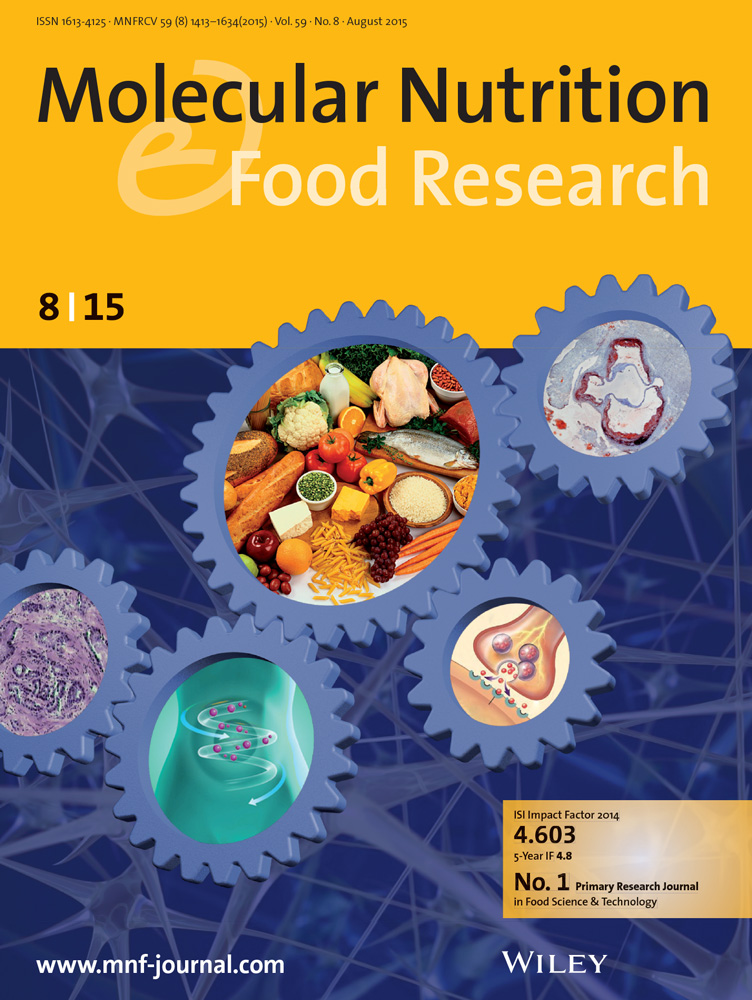微生物转谷氨酰胺酶增加人肠上皮中麦胶蛋白肽的摄取和易位。
IF 4.2
2区 农林科学
Q1 FOOD SCIENCE & TECHNOLOGY
引用次数: 0
摘要
转谷氨酰胺酶2 (TG2)通过修饰麦胶蛋白肽在乳糜泻(CD)的发病机制中起重要作用。此外,微生物转谷氨酰胺酶(mTG)与CD的发病机制有关,因为它以同样的方式修饰麦胶蛋白肽。mTG在食品生产中用作技术辅助,也可能由肠道微生物群释放。我们的目的是表征mTG与不同麦胶蛋白肽的相互作用及其对上皮和粘膜运输的影响。我们使用间接酶联免疫吸附法(ELISA)和免疫印迹法比较了mTG-和tg2介导的麦胶蛋白肽交联。用荧光法和免疫荧光显微镜测定Caco-2细胞和人十二指肠活检对麦胶蛋白肽P56-88和P31-49的上皮摄取。与TG2相比,mTG对不同的麦胶蛋白肽具有更高的亲和力。mTG使Caco-2细胞对麦胶蛋白肽P56-88和P31-49的摄取增加近10倍。最后,mTG增加了人十二指肠黏膜的摄取并与麦胶蛋白肽P56-88共定位。dmtg介导的麦胶蛋白肽的酶修饰是明显的,并影响上皮对潜在有害的麦胶蛋白肽的摄取。因此,在食品生产中不加鉴别地使用mTG可能对消费者构成潜在威胁。本文章由计算机程序翻译,如有差异,请以英文原文为准。
Microbial Transglutaminase Increases Uptake and Translocation of Gliadin Peptides in the Human Intestinal Epithelium.
Transglutaminase 2 (TG2) plays an essential role in the pathogenesis of celiac disease (CD) by modifying gliadin peptides. Additionally, microbial transglutaminase (mTG) was implicated in CD pathogenesis since it modifies gliadin peptides in the same way. mTG is used as a technical aid in the production of food items and might also be released by the intestinal microbiota. We aimed to characterize the interaction of mTG with different gliadin peptides and its effect on the epithelial and mucosal transport.We compared mTG- and TG2-mediated crosslinking of gliadin peptides using indirect enzyme-linked immunosorbent assay (ELISA) and immunoblot. Epithelial uptake of gliadin peptides P56-88 and P31-49 by Caco-2 cells and human duodenal biopsies was quantified by fluorometry and immunofluorescence microscopy. mTG had a much higher affinity towards different gliadin peptides than TG2. mTG significantly increased the uptake of gliadin peptide P56-88 and P31-49 by Caco-2 cells by nearly 10 times. Finally, mTG increased the uptake and colocalized with gliadin peptide P56-88 in the human duodenal mucosa. DmTG-mediated enzymatic modification of gliadin peptides is evident and influences the epithelial uptake of potentially detrimental gliadin peptides. The uncritical use of mTG in food production might therefore pose a potential threat for consumers.
求助全文
通过发布文献求助,成功后即可免费获取论文全文。
去求助
来源期刊

Molecular Nutrition & Food Research
工程技术-食品科技
CiteScore
8.70
自引率
1.90%
发文量
250
审稿时长
1.7 months
期刊介绍:
Molecular Nutrition & Food Research is a primary research journal devoted to health, safety and all aspects of molecular nutrition such as nutritional biochemistry, nutrigenomics and metabolomics aiming to link the information arising from related disciplines:
Bioactivity: Nutritional and medical effects of food constituents including bioavailability and kinetics.
Immunology: Understanding the interactions of food and the immune system.
Microbiology: Food spoilage, food pathogens, chemical and physical approaches of fermented foods and novel microbial processes.
Chemistry: Isolation and analysis of bioactive food ingredients while considering environmental aspects.
 求助内容:
求助内容: 应助结果提醒方式:
应助结果提醒方式:


